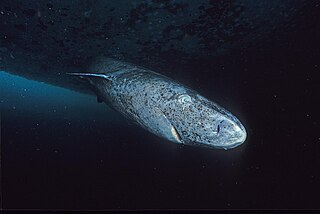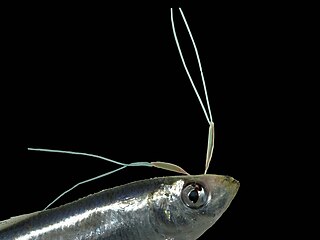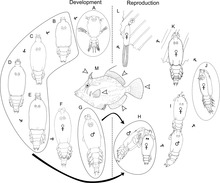
Copepods are a group of small crustaceans found in nearly every freshwater and saltwater habitat. Some species are planktonic, some are benthic, a number of species have parasitic phases, and some continental species may live in limnoterrestrial habitats and other wet terrestrial places, such as swamps, under leaf fall in wet forests, bogs, springs, ephemeral ponds, and puddles, damp moss, or water-filled recesses (phytotelmata) of plants such as bromeliads and pitcher plants. Many live underground in marine and freshwater caves, sinkholes, or stream beds. Copepods are sometimes used as biodiversity indicators.

Poecilostomatoida are an suborder of copepods. Although it was previously considered a separate order, recent research showed it to be nested within the Cyclopoida

Monstrilloida is an order of copepods with a cosmopolitan distribution in the world's oceans. The order contains a single family, Monstrillidae. The name of the first ever described genus Monstrilla is derived from latin, meaning "tiny monster", because the lack of usual diagnostic features of copepods puzzled early taxonomists.

Ommatokoita elongata is a 30 mm (1.2 in) long pinkish-white parasitic copepod, frequently found permanently attached to the corneas of the Greenland shark and Pacific sleeper shark. The parasites cause severe visual impairment, but it is thought that the sharks do not rely on keen eyesight for their survival. It was speculated that the copepod may be bioluminescent and thus form a mutualistic relationship with the shark by attracting prey, but this hypothesis has not been verified. It is the only species in the genus Ommatokoita, although a specimen has been found on the skin of Etmopterus princeps assigned to the genus but not species.

Crustaceans may pass through a number of larval and immature stages between hatching from their eggs and reaching their adult form. Each of the stages is separated by a moult, in which the hard exoskeleton is shed to allow the animal to grow. The larvae of crustaceans often bear little resemblance to the adult, and there are still cases where it is not known what larvae will grow into what adults. This is especially true of crustaceans which live as benthic adults, more-so than where the larvae are planktonic, and thereby easily caught.

Pennellidae is a family of parasitic copepods. When anchored on a host, they have a portion of the body on the outside of the host, whereas the remaining anterior part of the parasite is hidden inside tissues of the host.

Lernaeocera branchialis, sometimes called cod worm, is a parasite of marine fish, found mainly in the North Atlantic. It is a marine copepod which starts life as a small pelagic crustacean larva. It is among the largest of copepods, ranging in size from 2 to 3 millimetres when it matures as a copepodid larva to more than 40 mm as a sessile adult.

Stephanolepis cirrhifer, commonly known as the thread-sail filefish, is a species of marine fish in the family Monacanthidae. It is found in the western Pacific, in an area that ranges from northern Japan to the East China Sea, to Korea. Other common names for the fish include kawahagi (カワハギ,皮剥) (Japanese) and “쥐치” "Jwi-chi" (Korean). The fish grows to a maximum length of about 12 inches, and consumes both plant material and small marine organisms like skeleton shrimp. S. cirrhifer is host of the parasite Peniculus minuticaudae. Some minor genetic differentiation between S. cirrhifer born in the wild and those bred in a hatchery for consumer use has been shown. The fish is edible and sold commercially for culinary purposes in many Asian countries.
Lernaeopodidae is a family of parasitic copepods. The females are typically large and fleshy, and attach to the host permanently using a plug made of chitin called the bulla. The males cling on to the females using their antennae. The family contains the following genera:
Pennella is a genus of large copepods which are common parasites of large pelagic fishes. They begin their life cycle as a series of free-swimming planktonic larvae. The females metamorphose into a parasitic stage when they attach to a host and enter into its skin. The males are free swimming. Due to their large size and mesoparasitic life history there have been a number of studies of Pennella, the members of which are among the largest of the parasitic Copepoda. All species are found as adults buried into the flesh of marine bony fish, except for a single species, Pennella balaenopterae which can be found in the muscles and blubber of cetaceans and occasionally other marine mammals, and is the largest species of copepod.

Myoxocephalus brandtii is a species of sculpin fish in the family Cottidae. It is native to the northwest Pacific, with a range extending from the Sea of Okhotsk to Hokkaido and the Sea of Japan.
Archidactylina is a genus of copepods that contains only the species Archidactylina myxinicola, and is the only genus in the family Archidactylinidae. It is a parasite of the gill pouches of two species of hagfish found in Japanese waters, Eptatretus okinoseanus and Myxine garmani.
Peniculisa is a genus of marine parasitic copepods in the family Pennellidae.

Lepeophtheirus elegans is a species of sea lice.
Cardiodectes is a genus of copepods in the family Pennellidae. Species are parasites of fish.

Peniculus is a genus of marine copepods in the family Pennellidae. They occur worldwide and typically parasitize coastal or epipelagic fish, with the exception of Peniculus hokutoae that was found parasitizing a mesopelagic myctophid, Symbolophorus evermanni.

Peniculus hokutoae is a species of parasitic pennellid copepod. It was described in 2018 from a single female. The type-host is the myctophid fish Symbolophorus evermanni and the type-locality is off Japan. The Japanese name of this species is hokuto-kozutsu-hijikimushi.
Mycobacterium stephanolepidis is an acid fast, rod-shaped bacteria that can form either round or smooth colonies, without pigmentation. The species name is derived from the fish that it was first discovered for infecting, Stephanolepis cirrhifer. This species grows on Middlebrook 7H11 agar or egg slants after being incubated for 3–5 days at 30 °C. Mycobacterium stephanolepidis has catalase activity and urease activity, intermediate for iron uptake. The organism fails to show Tween 80 hydrolysis, nitrate reduction, or arylsulfatase activity. It does not gro on Middlebrook 7H11 agar with picric acid. It has very little growth with 5% salt." M. stephanolepidis is "susceptible to clarithromycin, doxycycline, and ciprofloxacin." It displays either intermediate and/or resistant to the anitbiotics rifampicin, streptomycin, kanamycin and amikacin.

Symbolophorus evermanni is a species of fish in the family Myctophidae. It is widely distributed in the Indian and Pacific Oceans. The specific name evermanni honors ichthyologist Barton Warren Evermann. It is also known as Evermann's lanternfish or Evermann's lantern fish.












